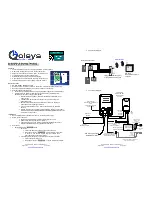
Sec ti o n 2:
Tr an s l ati o n c o n c ep ts
This section explains the basics of translation, shows example networks, and explains the
rules for translation.
The KMD-5551E translator connects between one or more KMDigital controllers and a
BACnet internetwork. The translator polls designated KMDigital controllers and adds them
as BACnet devices to a virtual BACnet network. The BACnet routing within the translator
makes the virtual network and devices available to any other device or operator workstation
on the internetwork. The devices on the virtual network can then be discovered and
manipulated within the Niagara frameworks as standard BACnet devices and objects.
Illustration 2–1 KMD-5551E translator block diagram
T
ie
r 2
B
A
C
n
e
t
ro
u
tin
g
T
ie
r 1
Translation
Translation
A
BACnet virtual
network and
devices
KMD controllers
and networks
B
C
D
E
A
B
C
D
E
Topics in this section
Translation rules
The KMD-5551E translator supports one Tier 1 controller and the controllers on one Tier 2
network. The Tier 2 network does not have to be connected to the Tier 1 controller.
l
KMDigital input, output, and variable points are translated as BACnet input, output, and
value objects.
l
Digital KMD points are translated to binary objects.
l
Analog KMD points are translated to analog objects.
l
KMD analog input points with Counts selected as units are translated as BACnet
accumulator objects.
l
Labels and descriptions in KMD points are translated as BACnet name and description
properties.
At power-up or reset, the translator scans for devices on the designated KMD networks. For
large networks the translator may take up to an hour to discover all devices and objects.
KMD-5551E Translator
Revision B
15
















































